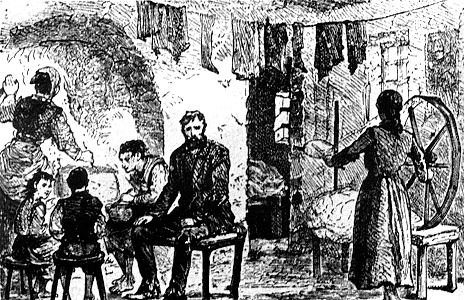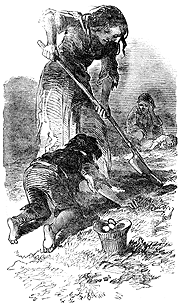The Great Hunger
Appalling Distress of the Poor in Navan
The London Times, 3 January 1837:
In the small town of Navan, county of Meath, about 26 miles from Dublin, a meeting was held on Thursday last, which was attended by the Rev. Mr. Hamilton, portreeve, the Rev. Robert Thompson, rector, Rev. Eugene O'Reilly, parish priest, and four resident magistrates.
It appeared from the reports submitted to the meeting, that the poor of the town and neighbourhood were in the most deplorable condition; that 310 families, comprising no less than 1,164 persons were in want of food. A subscription of £20 was received from the Earl of Essex, who is a large proprietor in the neighbourhood, and the collection on the spot amounted to £140, but this sum can afford nothing beyond the merest temporary relief during what may be regarded almost as a season of famine.

In the local papers of the time, the curtains blocking us off from the past are occasionally opened and we can see things as they were. At a meeting of the Guardians of the workhouse on 10 November, 1847, a motion - mooted by Mr. Skelly - was carried:
Mr. Skelly prefaced his resolution by calling the attention of the Board of Guardians to a detail of one of the most distressing scenes he had ever witnessed:

In fact it was 1852 before it could be asserted with confidence that the Famine had become an event of the past. From then on, it was noticed that the time of year when the workhouse had formerly held its largest population was no longer July, the cabbage season, when there was a gap between the end of the old potato supply and coming of the new; but February and March became the peak months for those on the poverty line to enter the workhouse, suffering from flu or winter hardship.
The conclusion for Ireland was inescapable - the problem of able bodied poverty had been solved once and for all by by the disaster of the Famine. The able bodied poor had been swept away to the emigrant boats - for the fortunate - or, as in most cases to the pauper's grave.
Source: Rev. Gerard Rice, Articles on the History of Navan, Meath Chronicle, 1980.
*******
A "hollow and unsubstantial" prosperity: poverty in nineteenth century Meath, Riocht na Midhe, 2013
The Commons of Navan, "the worse regulated of any common grounds...a receptacle for vagabonds from all quarters...
By the mid 1830's there was one pawnshop in the county based in the town of Navan. Mr. R. Fitzherbert, Justice of the Peace for Navan, believed that pawnbrokers do "incalculable mischief, being a great encouragement to dishonest practices among the poor". It appears that only people around Navan availed of the pawnshop but they were not the "lowest poor, for they have nothing to pawn."
Potato Blight 1879
This letter was published in the London Times, 10 Sept 1879 (30 years after the Famine)
Letter to The Times: Potato Blight
I have been in the habit of getting fresh seed of the champion potato from Scotland each year, and now, while the air is almost everywhere tainted with the smell of rotting potatoes, I can point with satisfaction to a crop almost free from disease, though, in the same field, my more conservative tenant has hardly a sound tuber to show.
I am, Sir, Your obedient servant,
N.T. Everard,
Randlestown, Navan.
Sept 6th 1879
*******
Notes: from The Great Famine in Co. Meath, by Danny Cusack, Meath Co. Co. 1995
During the decade 1841-51 the population of Meath declined by just over 23% from 183,828 to 140,748.
North Meath was more profoundly affected by the Famine than the southern part of the county. It had more dramatic losses in population. The nature of the rural economy was transformed by the near annihilation of the labourers, cottiers and small holders as a class.
The Gaelic culture and the once thriving Irish language of north Meath were dealt an almost fatal body-blow by the Famine. The once thriving tradition of Irish music and language, represented by such figures as Aodh MacDomhnaill of Drumconrath (1802-1867) went into rapid decline after the Famine.
Orphan Girls to Australia Scheme
In 1850 about 4,000 female orphans arrived in Australia from Irish workhouses as part of Earl Grey's (British Secretary of State for Colonies) Pauper Emigration Scheme. Approximately 100 of these girls were from workhouses in Meath and 25 were from Navan. The idea was to solve Australia's shortage of labour and imbalance of the sexes by alleviating the overcrowding in Ireland's famine filled workhouses.
The following made their way to Sydney on the "William and Mary" on the 21 November 1849 from the Navan Poor Law Union.
Betsy Boyle (16) near Navan. Parents John & Biddy (both dead)
Elizabeth Carry (16) Castletown. David & Mary (both dead)
Mary Clarke (15) Simonstown. Patrick & Peggy (mother in Navan)
Anne Clarke (18) Simonstown. Patrick & Peggy (mother in Navan)
Catherine Collins (14) Navan. Patrick & Mary (father living)
Bridget Cummins (16) Slane. John & Rose (both dead)
Mary Devine (16) Yellow Furze (Yellow Firs) Michael & Bridgey (mother alive)
Rose Donohue (16) Ardbraccan (Arbrattan) John & Margaret (mother in Navan)
Margareet Gray (17) Ardbraccan (Ardbrackhan..) John & Margaret (mother in Ardbraccan)
Julia Halligan (19) Navan. James & Jane (both dead)
Bridget Hammond (17) Navan. Michael & Rose (both dead)
Mary Kenny (16) Poremaine (near Boyerstown). Thomas & Mary (mother at Boyestown)
Jane Kenny (18) Churchown (near Ardbraccan). Thomas & Mary (mother at Churchtown)
Ann Lynagh (18) Navan. William & Margaret (mother in Navan)
Mary MacCormack (18) Navan. Thomas & Betty (mother in Navan)
Catherine Morris (18) Castletown. Edward & Catherine (both dead)
Mary Mullen (15) Navan. James & Biddy (both dead)
Bridgeet Mullen (17) Navan. James & Biddy (both dead)
Ann Murray (17) Albrack (?) Richard & Mary (mother in Navan)
Ann Smith (16) Castletown. James & Mary (both dead)
Catherine Vahey (17) Rathkenny (Rick Kenny) Thomas & Mary (both dead)
Many of these girls ended up in Bathurst New South Wales
Source: Danny Cusack, The Great Famine in Co Meath, quoting: Barefoot and Pregnant: Irish Famine Orphans in Australia, Trevor McClaughlin
See also: Fat Cattle and Mud Cabins in Pre Famine Meath and The Workhouse Solution